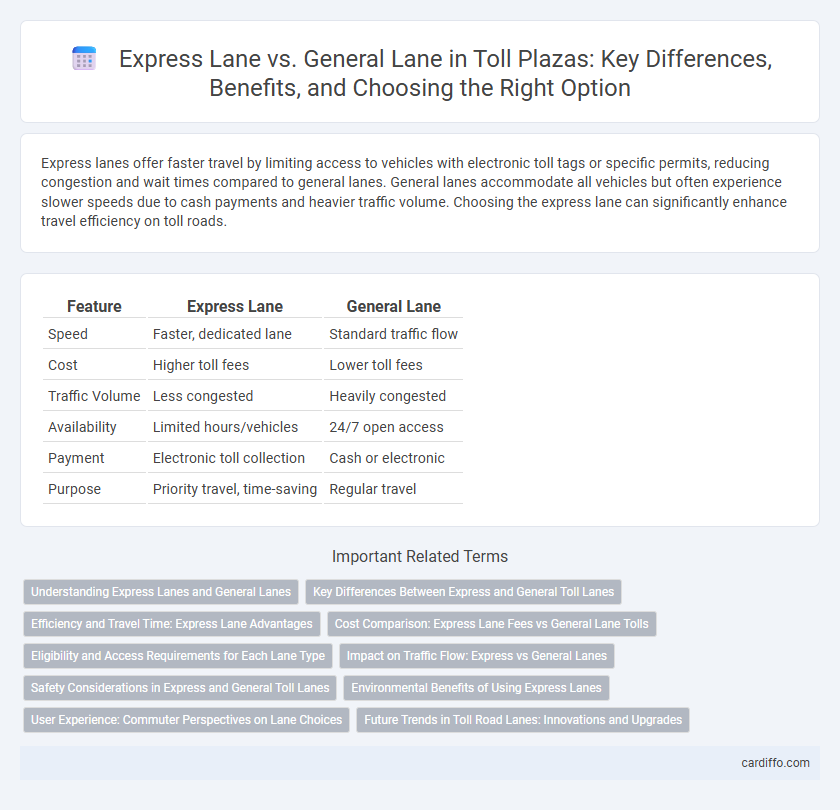Express lanes offer faster travel by limiting access to vehicles with electronic toll tags or specific permits, reducing congestion and wait times compared to general lanes. General lanes accommodate all vehicles but often experience slower speeds due to cash payments and heavier traffic volume. Choosing the express lane can significantly enhance travel efficiency on toll roads.
Table of Comparison
| Feature | Express Lane | General Lane |
|---|---|---|
| Speed | Faster, dedicated lane | Standard traffic flow |
| Cost | Higher toll fees | Lower toll fees |
| Traffic Volume | Less congested | Heavily congested |
| Availability | Limited hours/vehicles | 24/7 open access |
| Payment | Electronic toll collection | Cash or electronic |
| Purpose | Priority travel, time-saving | Regular travel |
Understanding Express Lanes and General Lanes
Express lanes are designated roadways designed to reduce congestion by allowing vehicles with electronic toll collection devices to bypass traditional toll booths and maintain higher speeds. General lanes accommodate all vehicles and require cash or card payments at toll plazas, often leading to slower traffic flow during peak hours. Understanding the operational differences between express and general lanes helps drivers optimize travel time and manage toll expenses efficiently.
Key Differences Between Express and General Toll Lanes
Express lanes typically offer faster travel by limiting entry to vehicles with electronic toll tags or high-occupancy vehicles, reducing congestion compared to general lanes. General toll lanes accommodate all vehicles but often experience slower speeds and longer wait times due to mixed traffic and cash payment options. Pricing in express lanes is usually dynamic, varying by demand, whereas general lanes charge a fixed toll rate.
Efficiency and Travel Time: Express Lane Advantages
Express lanes significantly reduce travel time by utilizing dynamic toll pricing to manage congestion, ensuring smoother traffic flow even during peak hours. These lanes prioritize vehicles with electronic toll collection, minimizing stops and delays compared to general lanes where toll booths and heavy traffic can cause bottlenecks. The efficiency of express lanes enhances overall commuter experience, promoting faster and more predictable travel times.
Cost Comparison: Express Lane Fees vs General Lane Tolls
Express Lane fees exceed general lane tolls, reflecting the premium service for reduced congestion and faster travel times. While general lane tolls typically range from $1 to $5 depending on distance, Express Lane fees can be double or triple that amount due to dynamic pricing models. Commuters prioritizing time savings often accept higher Express Lane costs, whereas cost-sensitive drivers prefer more affordable general lane tolls despite potential delays.
Eligibility and Access Requirements for Each Lane Type
Express Lanes require vehicles to meet specific eligibility criteria such as having a valid electronic toll transponder and often restrict access to carpool vehicles or those paying tolls via dynamic pricing. General Lanes are accessible to all vehicles without mandatory electronic toll devices and operate on a fixed toll rate system. Access to Express Lanes typically involves compliance with occupancy requirements or payment of variable tolls during peak periods, while General Lanes maintain consistent usage rules and pricing.
Impact on Traffic Flow: Express vs General Lanes
Express lanes significantly improve traffic flow by reducing congestion and allowing faster travel for vehicles willing to pay a toll. General lanes often experience slower speeds and higher variability in travel times due to higher vehicle density and frequent merging. The use of express lanes optimizes roadway capacity, decreases travel delays, and enhances overall traffic efficiency on highways.
Safety Considerations in Express and General Toll Lanes
Express lanes often incorporate advanced toll collection technology, reducing stop-and-go traffic and minimizing rear-end collision risks compared to general lanes. General lanes experience higher congestion levels, contributing to more frequent lane changes and increased potential for side-swipe accidents. Effective signage and lane markings in both lane types are critical to enhancing driver awareness and overall toll road safety.
Environmental Benefits of Using Express Lanes
Express Lanes reduce vehicle idling time by minimizing traffic congestion, leading to lower emissions and improved air quality. Vehicles traveling in Express Lanes maintain consistent speeds, which increases fuel efficiency and decreases carbon footprint. Studies show that optimized traffic flow in Express Lanes can cut greenhouse gas emissions by up to 20% compared to General Lanes.
User Experience: Commuter Perspectives on Lane Choices
Express lanes offer commuters a faster, more predictable travel time by reducing congestion through dynamic pricing, which encourages off-peak usage. General lanes provide a cost-free option but often experience heavy traffic and slower speeds, especially during peak hours, impacting overall travel efficiency. User preference typically balances the trade-off between toll costs and time savings, with frequent commuters favoring express lanes for reliability and occasional drivers opting for general lanes to avoid fees.
Future Trends in Toll Road Lanes: Innovations and Upgrades
Express lanes are increasingly integrating dynamic pricing algorithms to manage congestion and optimize traffic flow, leveraging real-time data from IoT sensors. Emerging trends include the deployment of AI-driven toll collection systems that reduce wait times and enhance lane efficiency compared to general lanes. Upgrades also focus on improving lane adaptability through vehicle-to-infrastructure (V2I) communication technologies, supporting autonomous vehicle integration and smart traffic management.
Express Lane vs General Lane Infographic

 cardiffo.com
cardiffo.com